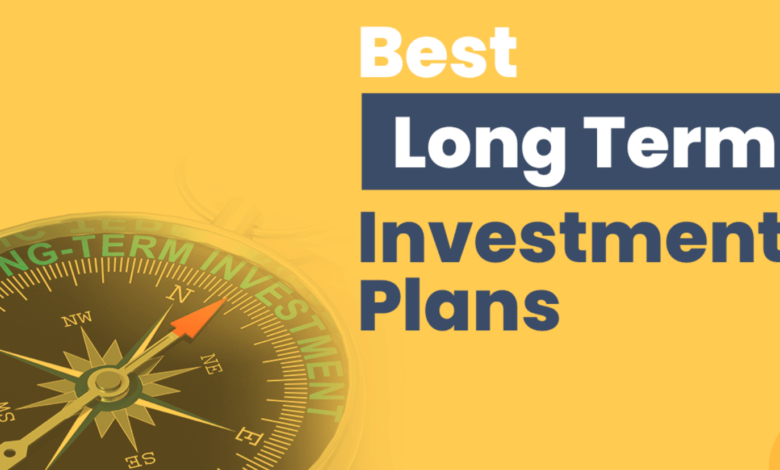What are the Best Long-Term Investment Plans?

Perhaps one of the best ways of accumulating wealth and protecting your finances is through long-term investment. Perhaps you are awaiting retirement or need the money to cater for your children’s education. As the goal is proper, the type of investment doesn’t matter since there is a very right investment in Canada for any objective in life. This blog will help establish the best long-term investment plans, their benefits, and how well tools like a Term Life Insurance Policy complement one’s financial strategy.
Why Long-Term Investment Matters
The growth for long-term investments is compounded. This simply means that the money will increase exponentially over time. Short-term investment plans are typically more rigid, with minimal flexibility to absorb market fluctuations and exploit higher yields.
Key Benefits:
- Compound interest: Your money makes money and then earns even more on that money.
- Risk Mitigation: Long-term plans mitigate the effects of short-term market volatility.
- Tax Efficiency: Many tax-efficient long-term investments can be made in Canada.
Registered Retirement Savings Plan (RRSP)
RRSP is the most significant long-term investment vehicle in Canada. RRSP was mainly designed to help Canadians save for retirement. The contribution made to an RRSP is tax-deductible, and the earnings grow tax-free until withdrawal.
Key Features:
- Tax Savings: Contributions reduce your taxable income.
- Diversification options: investing in mutual funds, stocks, bonds, and GICs with your RRSP.
- Contribution Room: Using 18% of your income up to a maximum annual limit.
RRSP Tip:
The RRSP savings being protected by Term Life Insurance may mean all the savings will be there in case of a sudden event, protecting your family’s future financial security while you continue to grow your investments.
Tax-Free Savings Account (TFSA)
Another great long-term savings option is the TFSA. Withdrawals from a TFSA are tax-free, which means they are good for any type of financial goal.
Key Features:
- Tax-free growth: income from your investment is not subject to tax.
- Flexibility: Use it in retirement, further education, and for whatever purpose.
- Contribution Limits: Accumulates annual contribution room.
TFSA Strategy:
To maximize the amount of money it can grow without taxes, take advantage of a TFSA to purchase high-growth assets like equities or index funds. Such tax-free compounding can supercharge your long-term growth.
Real Estate Investments
Indeed, real estate is a real, and often worthwhile, long-term investment in the country. Really, investing in rental properties, or a real estate investment trust, can harvest the benefits both of income streams and capital gain, on an investment.
Benefits:
- Steady Cash Flow: Rental income can provide a consistent revenue stream.
- Appreciation: Real estate values typically increase over time.
- Leverage: Use borrowed funds to maximize your investment potential.
Considerations:
Real estate is a high-capital investment with continuous management. However, they reduce the risk by incorporating it with financial tools, such as a Term Life Insurance Policy, which pays off the mortgage or any other debts in the event of a sudden event.
Mutual Funds and Exchange-Traded Funds (ETFs)
Mutual funds and ETFs are pooled investments that offer diversified, professionally managed investment. Good for investors wanting a long-term growth without making too much trouble.
Features:
- Diversification: Spread the risk over multiple assets.
- Affordability: Begin by investing with meager capital.
- Customization: Choose funds that match your risk tolerance and goals.
Tip:
Regularly invest in these funds to take advantage of dollar-cost averaging, which reduces the impact of market volatility over time.
Guaranteed Investment Certificates (GICs)
For risk-averse investors, GICs provide a safe and guaranteed way to grow your money. They offer fixed returns over a specified period.
Benefits:
- Safety: Your principal is guaranteed.
- Predictable Returyou’llow exactly how much you’ll earn.
- Flexibility: Choose terms ranging from one to ten years.
Best Use:
GICs are ideal for those nearing retirement or for individuals looking for a low-risk supplement to their portfolio. Combining a GIC with a Term Life Insurance Policy will ensure that your capital is secure and, at the same time, safeguard your loved ones.
Dividend Stocks
Dividend-paying stocks are an investment strategy that allows one to benefit from both steady income and long-term capital appreciation. Most Canadian companies, especially those in utilities and banking sectors, offer very reliable dividend payouts.
Advantages:
- Dividend income: Consistent payments of dividends.
- Reinvestment opportunities: Invest dividends in buying more shares and compound growth.
- Tax Advantages: In Canada, eligible dividends are treated leniently at tax.
Dividend Tip:
Select companies with a long history of paying consistent dividends. This minimizes the likelihood of reductions in times of economic stress.
Pension Plans
For those working in the public or private sector, pension plans are an essential component of long-term planning. These employer-sponsored plans provide a steady income stream in retirement.
Types:
- Defined Benefit Plans: Guarantee a specific monthly payout.
- Defined Contribution Plans: Contributions grow based on investment performance.
Integration:
Even with a pension, it’s wise to have supplemental investments, like an RRSP or a TFSA, to ensure you meet all your financial needs.
Whole Life Insurance as an Investment
Whole life is not just about protection; it’s also a type of investment, and your payments over the years earn you cash value against which you could borrow or help make future premium payments.
Key Features:
- Tax-Deferred Growth: Cash value grows tax-free.
- Dual Purpose: Combines life insurance with savings.
- Stability: Guaranteed returns on the savings component.
Why It’s Complementary:
Although a Term Life Insurance Policy is more affordable for pure coverage, whole life insurance offers an additional layer of financial planning.
Registered Education Savings Plan (RESP)
For parents, the RESP is an excellent long-term in children’s save for their children’s education. Contributions grow tax-free, and the Canadian government provides grants to boost savings.
Features:
- Government Grants: Up to $7,200 per child through the Canada Education Savings Grant (CESG).
- Tax Benefit: Growth is tax-sheltered until withdrawal.
- Flexibility: Spend on tuition, books, or any educational-related expense.
Read also: Top UK Business Account Features Transforming Small Enterprises
Balanced Investment Portfolios
A balanced portfolio will contain a mix of assets, including stocks, bonds, real estate, and cash equivalents. Diversification helps to minimize risk while optimizing returns.
Why It Works:
- Flexible: Adjust asset allocation based on life stage and risk tolerance.
- Stability: Bonds offer steady income, whereas stocks provide the opportunity for growth.
- Customizable: Tailor your portfolio to fit your long-term goals.
Planning Tip:
Review your portfolio regularly to ensure it remains in line with your financial goals.
How Term Life Insurance Supports Long-Term Investments
Although Term Life Insurance is not a technically termed investment per se, it allows a secured financial plan. A Term Life Insurance Coverage will ensure the family is secure if the uneventful act happens, meaning they can continue the investments planned.
Key Benefits:
- Affordability: Lower premiums compared to whole life insurance.
- Customizable Terms: Choose coverage for 10, 20, or 30 years.
- Peace of Mind: Protect your family from financial hardship.
How to Get Started:
Use Term Life Insurance Quotes Online to compare policies and find one that fits your needs. This ensures your financial goals remain intact, even in challenging times.
Choosing the Right Long-Term Investment Plan
The best investment plan for you will depend on your financial goals, risk tolerance, and timeline. Here’s how to decide:
- Evaluate Your Goals: Identify whether you are saving for retirement, buying a house, or for education.
- Understand your risk tolerance: The key thing is higher risk tends to mean higher return, but this is not in everyone’s pocket.
- Diversify: Never put all eggs in one basket. Spread the investments across the asset classes.
- Consult a Professional: Financial planners and Term Life Insurance agents help you decide the right proportion of investments.
Final Thoughts
Canada offers a wealth of long-term investment opportunities to suit every financial goal and risk profile. From the tax-advantaged accounts in RRSPs and TFSAs to more aggressive investments like high-yielding stocks in dividend names and real estate, there’s a plan that suits everyone. Isn’t it complemented by Term Life Insurance to provide for the ultimate security of financial planning despite whatever life throws at it?
You can even compare and then select a suitable policy for Term Life Insurance online with the aid of quotes. Long-term planning for your money is not all about how much you will build but also the protection you must have for such wealth. You can take your first step toward financial success right now.




